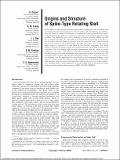| dc.contributor.author | Young, A. M. | |
| dc.contributor.author | Day, I. J. | |
| dc.contributor.author | Pullan, Graham | |
| dc.contributor.author | Greitzer, Edward M | |
| dc.contributor.author | Spakovszky, Zoltan S | |
| dc.date.accessioned | 2018-04-18T15:21:12Z | |
| dc.date.available | 2018-04-18T15:21:12Z | |
| dc.date.issued | 2014-11 | |
| dc.date.submitted | 2014-08 | |
| dc.identifier.issn | 0889-504X | |
| dc.identifier.uri | http://hdl.handle.net/1721.1/114778 | |
| dc.description.abstract | In this paper, we describe the structures that produce a spike-type route to rotating stall and explain the physical mechanism for their formation. The descriptions and explanations are based on numerical simulations, complemented and corroborated by experiments. It is found that spikes are caused by a separation at the leading edge due to high incidence. The separation gives rise to shedding of vorticity from the leading edge and the consequent formation of vortices that span between the suction surface and the casing. As seen in the rotor frame of reference, near the casing the vortex convects toward the pressure surface of the adjacent blade. The approach of the vortex to the adjacent blade triggers a separation on that blade so the structure propagates. The above sequence of events constitutes a spike. The computed structure of the spike is shown to be consistent with rotor leading edge pressure measurements from the casing of several compressors: the centre of the vortex is responsible for a pressure drop and the partially blocked passages associated with leading edge separations produce a pressure rise. The simulations show leading edge separation and shed vortices over a range of tip clearances including zero. The implication, in accord with recent experimental findings, is that they are not part of the tip clearance vortex. Although the computations always show high incidence to be the cause of the spike, the conditions that give rise to this incidence (e.g., blockage from a corner separation or the tip leakage jet from the adjacent blade) do depend on the details of the compressor. | en_US |
| dc.publisher | ASME International | en_US |
| dc.relation.isversionof | http://dx.doi.org/10.1115/1.4028494 | en_US |
| dc.rights | Article is made available in accordance with the publisher's policy and may be subject to US copyright law. Please refer to the publisher's site for terms of use. | en_US |
| dc.source | ASME | en_US |
| dc.title | Origins and Structure of Spike-Type Rotating Stall | en_US |
| dc.type | Article | en_US |
| dc.identifier.citation | Pullan, G. et al. “Origins and Structure of Spike-Type Rotating Stall.” Journal of Turbomachinery 137, 5 (November 2014): 051007 © 2015 ASME | en_US |
| dc.contributor.department | Massachusetts Institute of Technology. Department of Aeronautics and Astronautics | en_US |
| dc.contributor.mitauthor | Pullan, Graham | |
| dc.contributor.mitauthor | Greitzer, Edward M | |
| dc.contributor.mitauthor | Spakovszky, Zoltan S | |
| dc.relation.journal | Journal of Turbomachinery | en_US |
| dc.eprint.version | Final published version | en_US |
| dc.type.uri | http://purl.org/eprint/type/JournalArticle | en_US |
| eprint.status | http://purl.org/eprint/status/PeerReviewed | en_US |
| dc.date.updated | 2018-03-20T17:05:18Z | |
| dspace.orderedauthors | Pullan, G.; Young, A. M.; Day, I. J.; Greitzer, E. M.; Spakovszky, Z. S. | en_US |
| dspace.embargo.terms | N | en_US |
| dc.identifier.orcid | https://orcid.org/0000-0001-9625-1020 | |
| dc.identifier.orcid | https://orcid.org/0000-0003-2167-9860 | |
| mit.license | PUBLISHER_POLICY | en_US |
